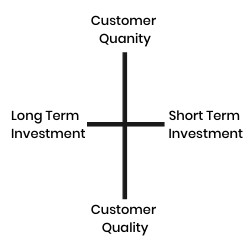How to Increase Your Adaptability

If this year has taught us anything it’s that being to react well to inevitability of change is a must-have trait. In venture investor Natalie Fratto’s TED Talk on adaptability, she focused on how we can work on a becoming more adaptable in the workplace.
Here are her three suggestions:
- Be proactive. Fratto says,“Adaptability has to be proactive, not reactive. We have to seek it out, exercise it and flex it like a muscle.” How can you seek out adaptability? Start by looking for gaps in your organization that need filled. For example, is your team having a hard time communicating with the podcast team? Take the opportunity to learn about podcasts and help bridge the communication gap. Putting yourself in a position to help can make it easier to adapt to new roles later.
- Look at things from another point of view. Being agreeable can actually be the opposite of adaptability. Occasionally (and respectfully) playing the devil’s advocate can help you and your team see things from a different viewpoint. This can prevent you from getting to attached to your opinions or view. Not being stuck to ideas promotes flexibility and creativity.
- Remember the times you changed your mind. “It’s helpful to write down the times where you were wrong, changed your mind, or made mistakes,” says Fratto. Instead of viewing the times you’ve made mistakes as negatives, view them in a more positive light. Focus on what you learned and how you were able to grow.
What ways have you had to adapt this year?
Can You Trust Your Data?

No matter how good the machine you build it is, it’s not going to run well if your fuel is poor quality. Data is the fuel the runs all marketing. The problem is, data error is commonplace. Data providers are all trying to give their clients the best data possible but often the data they are providing doesn’t match up.
Harvard Business Review did a study in May 2020 to test the accuracy of consumer data. They found that the accuracy of Demographic data was particularly disappointing. Most were only around 50% accurate. For example, the average accuracy of gender segments classifying males was only 42.5%.
“Half the money I spend on
– department-store magnate John Wanamaker (1838-1922)
advertising is wasted; the trouble is,
I don’t know which half.”

What do those errors mean for your campaign? A study by Forrester Consulting on behalf of Marketing Evolution in fall 2019 found that “marketers estimate that 21 cents of every media dollar spent by their organization in the last year was wasted due to poor data quality, which translates to a $1.2 million and $16.5 million average annual loss for mid-size and enterprise organizations, respectively.”
How do a few errors on a record level equal so much wasted money? Record level data is the spring from which everything else flows. For a small example, if a few records in your CRM have mistakes in them, what is going to happen when you use them to send an email campaign? The opens and clicks from your email campaign may inform your audience for your social campaign. In every step and trigger along your campaign, the small errors effect more and more information downstream.
The company Truth Set is looking to minimize error across all data. How? By providing a third – party consumer report type service for data providers and marketers. Truth Set goes through every record available and assigns a percentage rating to all the attributes, such as ‘percentage that this record is actually male.’ That way, marketers won’t waste money on inaccurate data and data providers can keep their data clean.

The hope is that as more time goes on, third party quality checks and ratings will become commonplace and shrink margin for error unilaterally.
What can you do make sure your data is accurate? There are a few easy identifiers you can check for. How old is the data? How transparent is the provider with where the data came from? How consistent and relevant is it?
What changes do you think would make it easier for marketers to trust their data?
How To Digital Advertise Effectively

With things changing around us so quickly, having a long-term advertising strategy can be a challenge. We need real time audience data as much as possible. How can we build an adaptable audience in this rapidly changing world?
One of the biggest changes in advertising this year was the extreme shift to digital. In an eMarketer poll, 56% of people said that they increased their online shopping this year. And 14% said that they shopped online for the first time. The way we shop has also changed. Because of the increase in online shopping, we tend to make faster, more impulsive purchase decisions. What does that mean for advertising?
Before the necessary shift to digital, brands could interact with customers in a wide variety of ways, often spread out over large physical distances. Billboards, signs, posters, newspapers, and magazines all exist with in different physical spaces. With digital advertising however, we are all competing for the same ad space. That ad space is worth more now has less guarantees attached to it.
Having the right audience is the foundation for your campaign…..
Asking yourself simple questions about your clientele such are gender, age, income, and possible other interests can make it easier to target more efficiently.

What can you do then make sure your potentials are seeing your brand? Start with the right people. A lot of marketers view the audience as a small detail or a piece of the puzzle. Having the right audience is the foundation for your campaign. Asking yourself simple questions about your clientele such are gender, age, income, and possible other interests can make it easier to target more efficiently.
Having a general idea of your audience is a good first step. Slowing narrowing down that audience helps reduce costs. A trigger-based campaign is a good way to do that. For example, you can send an email to a large amount of people who fit your initial criteria rather cheaply. Since social ads are more expensive, you then only need to advertise to the people for clicked or opened your email. You can then retarget them with Direct mail. Learn about your audience from each channel individually then apply it back to your campaign as a whole.
As difficult as it can be to have to shift an entire advertising strategy, it can be also be a great opportunity for growth. Using different channels can help you take a step back and look at your campaigns and your potentials in a new light. What have you learned about adapting strategies this year?
The End Of The Cookie: Part 2

What is going to fill the void left by third party cookies? We know for sure that our reliance on data isn’t going to change. It’s the foundation of marketing. we are always going to need to know who our audience is.
Three third party cookie alternatives.
- Use browsers history only to influence impressions. This is a very simple option that wil be easy to implement because things like google analytics pretty much already do this. But because its browser specific it could make OmniChannel marketing a challenge.
- First party identity information. This solution creates a unique ID for your web use. This option is popular with a lot of people in the commercial industry because even though your data pool will go down, using unique ids will give a higher match rate. Meaning if one of these matched personal ids show up in your system, you’ll know for sure that they are a solid prospect.
- Aggregated consumer data. This is somewhat of a catch all option, using consumer data from multiple sources to cross refence and match information. One advantages of this option is that marketers we be able to learn more about their consumers. Although you will know more about them as people, it’s unlikely that you will be able to actually know who they are.
So, what now? Now is the time to figure out as much as you can about your audience. It will be more of a challenge to find out who your customer base is without third party cookies. Focus on diversify into omnichannel marketing to get a clearer picture of your audience. It is also a good time to plan out a marketing strategy. Figure out what companies you are going to need relationships with going forward.
What alternatives to you think are going to fill the void left by third party cookies?
Can You Be An Email Campaign Guru

Before you even get started, make sure your tools/programs are all set up and integrated. Integrating programs is one way to streamline your workflow. Brainstorm other ways to streamline workflow. Working efficiently will make it easier to keep track of all the pieces needed for your campaign. And it will also help you work faster.
Once you are ready to send, use data from previous campaigns to optimize future ones. Are you sending to the right people? How about at the right time? Are there any issues within your system that could be making it hard for your campaign to reach its intended target?
How about after you’ve sent your campaign? What can you do to maximize its effectiveness? Are you collecting data from your campaign? Are you using it to retarget those in your campaign? Think about how your customers perceive your brand as a single entity can help you develop your relationship with them smoother.
Sharing information from your campaign across every channel helps you to appear more cohesive. Also sharing data gleaned from your campaign within your organization can make you more effective and efficient. Sharing is caring!
Is Insight In Marketing Important?

What is the difference between using data and using data effectively? Having insight or discernment is the key. Think about the old adage: knowledge is knowing that a tomato is a fruit, wisdom is knowing that it doesn’t belong in a fruit salad. Therefore if data = knowledge, then insight helps you to now where to put it effectively.
For years, marketing strategies and programs were laid out the same way. Now due partly to social media and digital marketing capabilities, people want a personal experience. That experience based marketing is only possible if you can use the right data in the right way.
Many companies start off by trying to get as many customers a possible. Then after a certain point, they level off because they don’t know who their customers are or how to reach them.
Once you have figured out your audience, it can be hard to know whats the next step.

Data marketing company V12 suggests making a chart with long term vs short term investments on one axis and customer quantity verses quality on the other. Then fill in the chart with all of your possible marketing strategies, programs, and solutions. Thinking about possible strategies this way makes it easier to formulate a plan that yields the biggest bang for your buck.
In what ways do you that insight helps a marketing strategy?
Marketing Tactics That Will Actually Make You Poor
 It’s so frustrating.
It’s so frustrating.
You heard some advice that really seemed to make so much sense, so you go for it. All in, 100%.
But then you grind and grind and nothing happens. You stay up late and hustle for every single response. It’s like you’re spinning your wheels, not getting anywhere.
What’s the problem? Does the idea even work?
Good news: marketing still works, and really well. Don’t give up. But there are a lot of popular tactics that won’t move the needle.
So why not ditch the useless ideas and start upping your game (and results) with what’s actually working? But to do this, you need to recognize these tactics that make you poor.
Here’s the first one…
Investing In That New Thing Because Everybody’s Doing It
Take AI, for example. Accenture Interactive says 80% of B2B marketers feel AI will revolutionize marketing.
Yet Andrew Stephen, writing for Forbes points out:
Look how easy it is to get Siri or Alexa confused – just ask the wrong question. Data quality is a huge issue. Garbage in, garbage out. If you feed poor marketing data to AI, you fail to get results.
Another big issue? Nobody agrees on the terminology yet.
Greedy sharks are throwing out fancy tech words and making big promises… But if you don’t carefully find out what they’re talking about, you’ll get sucked in. All your money gone. Nothing in return.
Slap together an audience selection tool, choose a few triggers, time a few messages and voila! A brand new “AI” thing with a big price tag. “Of course you should buy it,” they say. “Everybody’s getting into AI.”
Newsflash: it’s not really AI. And marketers have been using this simple, relatively inexpensive process (audience selection, triggers, message timing) for years.
Yes, you should innovate, disrupt and adopt new things, but… how much more profitable to ask yourself first: Where’s my business really at? What growth stage am I in?
If you’re a small business or just starting out, you definitely don’t need an advanced-stage marketing tactic with a high-dollar price tag on it. No matter how successful people say it is.
What to do instead?
Go back to the basics. Look at the marketing that’s always worked and still does: Pick up your phone and call people. Send emails. Leverage direct mail. There’s a far more predictable success rate here.
People know this, but why do so many still avoid what works?
It’s because you’re told to…
Just Do The Marketing That’s Comfortable
Maybe you hate selling face to face. Or on the phone. That’s why those supposedly enlightened gurus say, “Do what you love.” True, it helps to be excited about your work. And you should always sell yourself on what you’re doing.
But if you take these “follow your passion” phrases literally, you’re on a road that leads to…dead broke. So many of these traditional-marketing haters decide that digital is the only way to go, so they…
Hide behind the keyboard and pray to get rich quick.
And some metrics are so misleading. One Twitter influence metric can rank you in the top 2% of your industry, even if you have almost no clicks through to your website.
Other people crank out video after video on Facebook Live or Periscope. And while this works for some…
Hearts and thumbs up will not pay your bills.
What about paid advertising? Will you get the results you want with Facebook audience targeting? Let’s say you want to target everyone on Facebook with a yearly income of $50,000+ who also like boating.
But if you’re not targeting that same audience with mail and email, what are you missing?
Guaranteed, there are quite a number of middle-class boat enthusiasts who don’t really use Facebook that much. And an even larger number who might use Facebook, but they won’t get into your sales funnel this way.
Speaking of funnels, ever heard of click funnels? You can spend a truckload on these – but how much money will they really make you?
Granted, some people make a living with these things. Yet how many businesses are finding out the hard way that they aren’t what they thought.
What to do instead?
Even digital marketing experts agree: don’t sell directly on social media. The only purpose of social should be to get people onto your website and your email list. Where you can… sell them directly.
Ask yourself: What is going to get me to my audience the quickest? How do I get in front of people who will spend money? What’s the quickest way there?
Inevitably, this leads you back to the basics… calling people, collecting and sending emails, using direct mail.
Here’s another road to the poor house…
Free Training
Just because somebody says is free doesn’t make it free.
What if somebody called you up today and gave you 3 full days of free training? And what happens, if after 3 days, you realize: well, that was kinda cool, but I knew most of it already. Common sense stuff.
Or they show you only one piece, just one of the many ingredients you actually need to succeed.
And in case you hadn’t figured this out… free training is there to sell you something. And of course the presenter makes it look SO easy. But the reality is, what you learned can sometimes take you months or even years to get set up and working profitably.
Truth is, those 3 days didn’t REALLY help you. You could have been using your time to actually get customers. So how expensive were those 3 days…really?
Well, how much do you WANT your time per hour to be worth? And once you’re actually worth that much per hour, you’re going to get paid that much. Without fail.
What to do instead?
Be very intentional with what you learn. When you write out your goals, ask yourself: what exactly do I need to learn to reach these goals?
And then force yourself to learn ONLY those things. Don’t get distracted.
What All This Means For You
Small and medium-sized businesses are getting fleeced by so many schemes and scams. All while good old-fashioned phone calls, direct mail and email marketing will help your business grow.
Think of what stage you’re at in your business. If you’re mowing lawns (or anywhere near just getting started with your business – you know who you are), you don’t need click funnels or AI.
Maybe you just need to use door hangers. Or a sign on your car. Or pound the phone. Even Mark Zuckerberg got Facebook started by sending a bunch of emails to his college buddies.
Sure, there are all those cool, shiny, fantastic marketing tools out there. But they may not be for you. At least not yet.
But if you stay focused and stay away from all these distractions, you can actually take your business to the next level. The level where there’s no more frustration, stress and worry about what works. Where there’s freedom to play with new ideas and options.
Where growing your business is fun again.
| Click here to learn more |
A Huge Mistake That Will Kill Your Profits Immediately
 At first everything was great. Tens of thousands of customers accept offers and cash in on coupons. The customer analytics data pouring in is an absolute gold mine.
At first everything was great. Tens of thousands of customers accept offers and cash in on coupons. The customer analytics data pouring in is an absolute gold mine.
Any company would love to have these solid, specific, fresh details: what offers people are actually responding to, when, what they’re buying, how they’re buying, what they’re ignoring and what they buy again.
But then the bottom dropped out…
The marketing director suddenly decided to ignore all this precious response data and go in a new direction. Months later? Sales are stagnant and everybody wonders what happened.
2017 was a bloodbath for companies making stupid mistakes like this. And sadly, the trend will continue. Why? It doesn’t have to happen, but people simply refuse to learn to market. “You’re selling from your heels,” the well paid expert explained to the nearly dead company. How does he explain the advice?
“It means you don’t 100% believe in what you’re doing.”
Despite all the hard work they put into marketing, tracking customer behavior, analyzing the data and sending out more offers… they threw it all in the trash.
Let’s say you have an employee. He’s a likeable and friendly salesman. But there’s a customer with deep pockets standing outside your door. And a whole week goes by. The customer still passes your door, pausing, waiting for an invitation to come in and buy. But your employee does nothing.
How long would you keep this employee?
Do you make this same blunder with your response data? It cost you real time, effort and money to execute marketing campaigns, track customer behavior and then store the data. Yet if you do nothing with it, this will cost you far more money than you ever spent to get the data.
In one study, 93% of businesses say data is important (or very important) to their success. Yet some companies lie to themselves: “Oh yes, we use our data.” But the truth is, they don’t send out any marketing until the next quarter. Data from the last quarter or last year?
It’s actually rotten by now. Unusable.
Nobody can deny it. Our business environment is changing so rapidly it takes real focus to keep up. It’s vital to know exactly who your target audience is… this month, this week, today. And it’s becoming essential for survival to use behavior data to narrow your focus down to who is going to buy right now.
Let’s say your analytics find 100,000 people who look just like your current customers. Yet predictive modeling shows that only 15,000 of these people will buy immediately. You’re smart. You don’t dismiss the other 85,000. You simply market to them differently than the 15,000.
You keep on digging. You find 5,000 among the 15,000 who become the prime focus of your marketing initiative. And you send out offers to them at least every month.
Companies who will dominate this year have a strategy and a plan that includes action like this. Are you starting to appreciate why it’s absolutely critical that you use really reliable data?
And then act on it?
The biggest mistake companies make is failure to take action. Enough action. Often enough. To grow their business and achieve the results, success and freedom they want.
Don’t make this mistake. Guard your data. Use your data. Refresh your data. Profit from your data.
Let’s make this year the best one yet.
| Click here to learn more |
How to Succeed With The One Habit of Highly Effective Marketers
This one habit is everything: finding the right people.
Because let’s face it, this is more important than all the sales methods, copywriting techniques and negotiating tactics in the world. The wrong person doesn’t have the money. Or they don’t care. Or may not be as easy to convince.
If your marketing doesn’t get you in front of the right people, you’ll never sell. Plain and simple. Yet even this is not enough. In these competitive times, if you try to sell to everyone who will buy…you will fail.
Starbucks understands this. They know that 40 out of 100 people are willing to pay 50 cents for a cuppa joe. Yet they find and focus only on the 8 people willing to pay $2 to $5 for the luxury blends. (And this is why all those corner coffee shops went out of business.) If you’re not targeting the crucial 20% of your audience (or 10%), you need to learn how. And how do you do it?
Predictive analytic models.
Yes, there are a variety of these models to increase your revenues and delight your customers. But don’t let all the science or choices scare you. Here are some (hopefully) simple, real-world examples to help you know what to do.
Think of these models as tools in a toolbox. (You wouldn’t use a saw if you needed a hammer.)
First, just like in the Starbucks example above, you need to segment (or cluster) your audience. Who are the 50-cent people? Who are the $5 people?
This is not just demographics like age and zip code. Want to delve deeper and get a more profitable answer?
Customer Behavior
Some of your customers may be big spenders on their first order. Others may purchase less at a time but be more loyal, long-term buyers. Still others may buy more because of discounts. Do they contact you via your website, in person or use the phone?
Not only could you look at average order size or total revenue for each…what about days between orders? Total number of orders? Total items per order? Size of first order? Number of products in their first order? Percentage of spending on discounted items?
Let’s say you have a group of frequent buyers with small orders. A simple offer like this could really increase your profits: “Earn double reward points when you spend $20 or more.”
You could also segment your customers by product. Do they like coffee or tea? French or Italian roast? If you represent multiple brands, which brands do your best customers prefer? Which brands do they have the least interest in?
Have you thought through who your best customers are (or might be)? Talk to an experienced data provider about this kind of segment/cluster modeling to help you analyze your own buyer data. And once you know who your very best customers are, you still need to find more people like them. How?
Propensities Predict Profits
The best data companies can also match your best customers with their records – and find a whole lot more of the best kind of people, ready to buy from you. From this new, larger list, propensity modeling can rank each listed person a number of ways:
You can predict someone’s…
- Future lifetime value as your customer – even before they buy from you. This data also tells you their demographics, email and what channels they use to buy. Can you see just how valuable this is when choosing how to market to them?
- Share of wallet. For example, if a customer spends $100 with you, is this 10% or 90% of their total spending on this type of product/service for a given time period? If you know your future revenue potential with them, you can design campaigns to capture this money.
- Propensity to engage. If they don’t click on emails, you don’t want to send emails to them. Or you might see that they will answer the phone or open direct mail.
- Propensity to unsubscribe. This allows you to know how often to send them emails. If they are good buyers but likely to unsubscribe, send them emails, but less often.
- Propensity to convert. You already spend enough getting offers in front of people. Reduce your spending by only putting offers in front of people likely to respond.
- Propensity to buy. When you know who is ready to buy and who isn’t, you also know how aggressive to make your offers. And ready prospects don’t need high discounts. Stop eating up your margin with them. (But you might want to make more aggressive offers to get incremental profits from people who are still high value.)
- Propensity to churn. One auto insurance company used this model, calling it their Auto Insurance Switcher model. Think of how profitable it is to know who is likely to buy your insurance now but switch next year to get the current cheap rate. Instead, you can reduce ad spending while increasing profits – all by targeting people more likely to stay with your company.
What You Must Know About Propensities
Propensities, when used right, can be scary accurate. They can predict what people will do, long before even they realize what they are going to do. Yet this kind of math has lots of variables. Here are a couple common ways to fail:
- Use one provider to analyze your data, but buy your list from another vendor.
- Use one set of methods to select your best customers, but another set of criteria for your prospect list.
A good data partner can help you gather your data, compile reports, identify your audience and best prospects. Every winning company this coming year will take their data and their data partner very seriously.
After all, finding the right people is the one habit of highly effective marketers.
What will you do? How do you find the right people?
| Click here to learn more |
